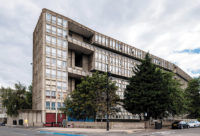But now redevelopment, according to a Rafael Viñoly masterplan, is well in hand. The latest architects to be hired—for the third phase of the site—are Gehry Partners and Foster + Partners Architects, whose new buildings will face each other on a new southern approach to the development. Plans for the power station hulk itself, by architects Wilkinson Eyre, are due to be unveiled on November 5.
The Gehry and Foster buildings will act as the gateway to the whole development along a new street. The two architects will together deliver the overall third phase of the mighty project, Gehry on the east side and Foster on the west. It will consist of 1,200 apartments, a 200-room hotel, a 15,000-square-foot public library, and 350,000 square feet of retail and restaurant space. Completion is slated for 2019.
The power station’s 1930s architect was the acclaimed Giles Gilbert Scott (1880-1960), designer of Liverpool’s Anglican cathedral and the iconic British red telephone kiosk. Scott was also responsible for the later, single-chimney Bankside Power Station downstream, now better known as the Tate Modern contemporary art gallery, converted by Herzog & de Meuron. Battersea—built in two halves in the 1930s and 1950s—has not had Bankside’s luck, despite being listed as a historic monument, which Bankside is not. It has passed through several owners, with changing plans by many architects, including Grimshaw. Drawn up for the previous owner and officially approved in 2011, the Viñoly masterplan was adopted in its entirety by the present owners, a consortium of Malaysian investors behind the British-based Battersea Power Station Development Company.
Gehry’s contribution will be his first permanent London commission; he has previously designed one of the Serpentine Gallery’s annual temporary pavilions. Welcoming the collaboration with Foster, Gehry said: “Our goal is to help create a neighborhood and a place for people to live that respects the iconic Battersea Power Station while connecting it into the broader fabric of the city.” That broader fabric includes the adjacent quarter of Nine Elms, where a business district is planned around the new United States embassy by KieranTimberlake. An extension to the London subway network will link both Battersea and Nine Elms to the city center. Foster’s own practice built its studio on the nearby riverside—then a postindustrial wharf area—nearly 25 years ago.
The first phase of the Battersea Power Station project, now under construction, consists of housing and mixed-use blocks at the western side of the site by Ian Simpson Architects and dRMM architects. The second phase will include the demolition of the power station’s currently unstable, cream-colored, fluted concrete chimneys and the construction of exact replicas.
Viñoly was not expected to compete for the third phase of the work, said a spokesman for the company. “It was always the intention to have a number of different architects working here,” she said. “Mr. Viñoly is still much involved, we see him in the building a lot.”




Post a comment to this article
Report Abusive Comment